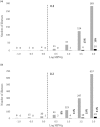Developing a risk management framework to improve public health outcomes by enumerating Salmonella in ground turkey
- PMID: 30520390
- PMCID: PMC6518596
- DOI: 10.1017/S095026881800328X
Developing a risk management framework to improve public health outcomes by enumerating Salmonella in ground turkey
Retraction in
-
Developing a risk management framework to improve public health outcomes by enumerating Salmonella in ground turkey - RETRACTION.Epidemiol Infect. 2022 Jul 4;150:e124. doi: 10.1017/S0950268822000954. Epidemiol Infect. 2022. PMID: 35786444 Free PMC article. No abstract available.
Abstract
Salmonella spp. continue to be a leading cause of foodborne morbidity worldwide. To assess the risk of foodborne disease, current national regulatory schemes focus on prevalence estimates of Salmonella and other pathogens. The role of pathogen quantification as a risk management measure and its impact on public health is not well understood. To address this information gap, a quantitative risk assessment model was developed to evaluate the impact of pathogen enumeration strategies on public health after consumption of contaminated ground turkey in the USA. Public health impact was evaluated by using several dose-response models for high- and low-virulent strains to account for potential under- or overestimation of human health impacts. The model predicted 2705-21 099 illnesses that would result in 93-727 reported cases of salmonellosis. Sensitivity analysis predicted cooking an unthawed product at home as the riskiest consumption scenario and microbial concentration the most influential input on the incidence of human illnesses. Model results indicated that removing ground turkey lots exceeding contamination levels of 1 MPN/g and 1 MPN in 25 g would decrease the median number of illnesses by 86-94% and 99%, respectively. For a single production lot, contamination levels higher than 1 MPN/g would be needed to result in a reported case to public health officials. At contamination levels of 10 MPN/g, there would be a 13% chance of detecting an outbreak, and at 100 MPN/g, the likelihood of detecting an outbreak increases to 41%. Based on these model prediction results, risk management strategies should incorporate pathogen enumeration. This would have a direct impact on illness incidence linking public health outcomes with measurable food safety objectives.
Keywords: Ground turkey; pathogen enumeration; risk assessment; salmonella.
Figures



References
-
- Marder EP et al. (2017) Incidence and trends of infection with pathogens transmitted commonly through food and the effect of increasing use of culture-independent diagnostic tests on surveillance-foodborne diseases active surveillance network, 10 U.S. sites, 2013–2016. Centers for disease control and prevention. Morbidity and Mortality Weekly Report (MMWR) 66, 397–403. - PMC - PubMed
-
- Food Safety Inspection Service (FSIS) database. Available at http://www.fsis.usda.gov/wps/wcm/connect/180fc804-0311-4b4d-ae42-d735e82... (Accessed April 2017).
-
- Food Safety and Inspection Service (FSIS) (2015) Changes to the Salmonella and Campylobacter verification testing program: proposed performance standards for Salmonella and Campylobacter in not-ready-to-eat comminuted chicken and turkey products and raw chicken parts and related agency verification procedures and other changes to agency sampling. Federal Register 80, 3940–3950.
Publication types
LinkOut - more resources
Full Text Sources
Miscellaneous

